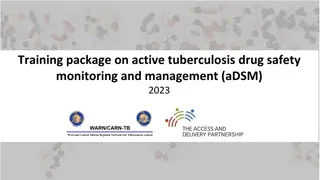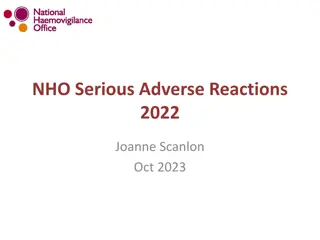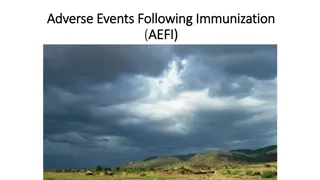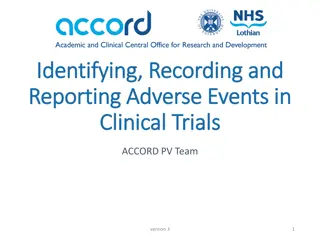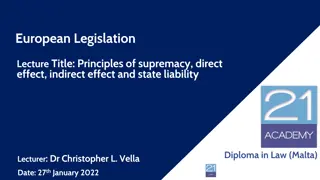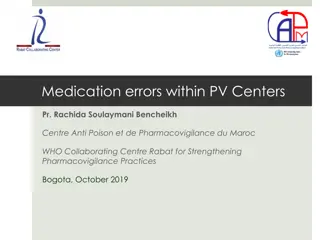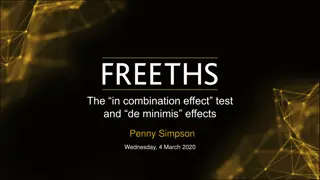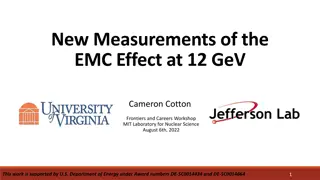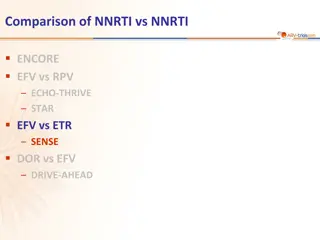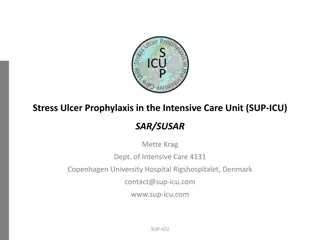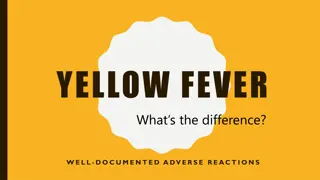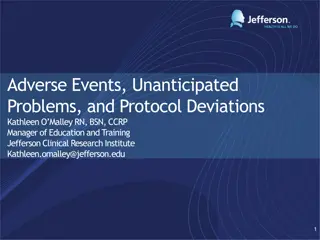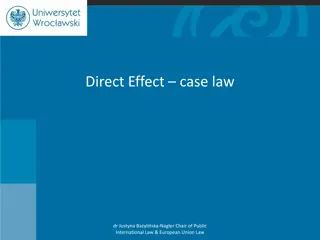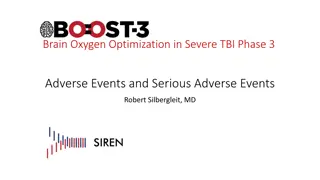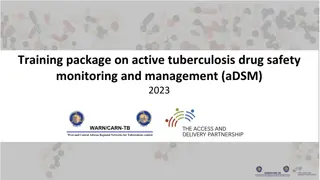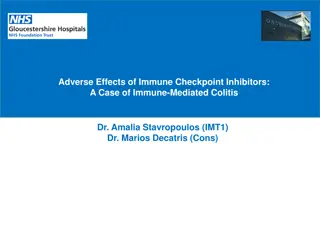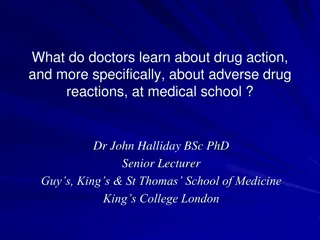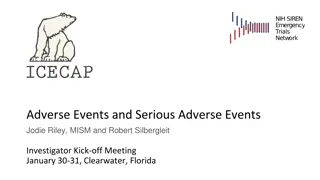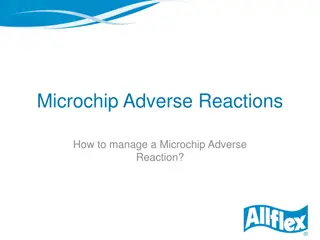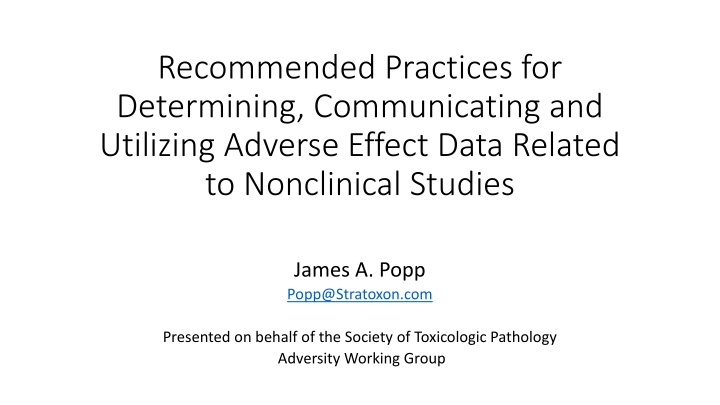
Best Practices for Adverse Effect Data
Practices for determining, communicating, and utilizing adverse effect data from nonclinical studies. Recommendations by the Society of Toxicologic Pathology Adversity Working Group to improve identification, communication, and utilization of adverse effects. Objectives include enhancing product development efficiency through improved reporting.
Download Presentation

Please find below an Image/Link to download the presentation.
The content on the website is provided AS IS for your information and personal use only. It may not be sold, licensed, or shared on other websites without obtaining consent from the author. If you encounter any issues during the download, it is possible that the publisher has removed the file from their server.
You are allowed to download the files provided on this website for personal or commercial use, subject to the condition that they are used lawfully. All files are the property of their respective owners.
The content on the website is provided AS IS for your information and personal use only. It may not be sold, licensed, or shared on other websites without obtaining consent from the author.
E N D
Presentation Transcript
Recommended Practices for Determining, Communicating and Utilizing Adverse Effect Data Related to Nonclinical Studies James A. Popp Popp@Stratoxon.com Presented on behalf of the Society of Toxicologic Pathology Adversity Working Group
Background STP Activity Draft recommendations Initially formulated by the Adversity Working Group of the Society of Toxicologic Pathology Modified based on comments from numerous STP members Further refinement will be considered based on additional suggestions for modification Your comments are welcome and appreciated Final version of recommendations will be published in the journal Toxicologic Pathology
Society of Toxicologic Pathology Adversity Working Group Brad Bolon The Ohio State University John Burkhardt Abbvie Sabine Francke U.S. Food and Drug Administration Peter Greaves Leicester Royal Infirmary (UK) Roy Kerlin (Chair) Pfizer Vince Meador Covance James Popp Stratoxon Recommendations reflect the opinion of Working Group members and are not the official position of their employers or the STP
Adverse NOAEL Identification of an adverse effect leading to the designation of a NOAEL in nonclinical studies has too frequently resulted in confusion, misunderstandings and in some cases unnecessary contentious situations Agreement or standardization of basic principles related to adversity and NOAEL could vastly improve the understanding and importance of nonclinical study results for clinicians and regulators
Basic Issues Related to Use of the Terms Adverse and NOAEL Inconsistent approaches and opinions related to what effects are Adverse thereby affecting the NOAEL Variable approaches for communicating adverse effects in nonclinical studies Report Summary Documents Data tables Differences in approaches and opinions related to using adverse effect data and NOAEL in the assessment of human risk
Objective of STP Effort Primary Objective Develop recommendations to improve the Identification Communication Utilization of adverse effects found in nonclinical studies Ultimate Objective Contribute to more effective and efficient product development through improved communication and reporting
Background Adversity and NOAEL Multiple and sometimes conflicting definitions of adversity have been provided in the literature (reference analysis included in publication) Concept of adversity has been variably based on: Objective evaluation of data (statistical assessment) Subjective evaluation of data (consideration of broader knowledge of biology including tissue, cellular and molecular understanding of responses to xenobiotics) Professional judgment relying on either or both objective and subjective assessment of data
Recommendations Recommendations of the STP Adversity Working Group are presented in the order they apply in the course of performance and communication of results from a nonclinical study Three sections of recommendations Determining Adversity and NOAEL Communicating Adversity and NOAEL Using Adversity and NOAEL in assessing human risk
Recommendation 1 (Determining Adversity and NOAEL ) Adversity is a term indicating harm to the test animal within the constraints of a given study design (dose, duration etc.) Comment Not all changes are harmful (i.e. capable of detrimentally impacting an animal s performance or lifespan, either under normal conditions or if challenged) Only harmful changes are adverse Test article-related changes that are not harmful are non-adverse
Recommendation 1 (Determining Adversity and NOAEL ) Adversity is a term indicating harm to the test animal within the constraints of a given study design (dose, duration etc.) Additional comment Reversibility alone is insufficient evidence to determine adversity Reversibility data can be useful for confirming an assessment of adversity Reversibility may impact the subsequent assessment of human risk
Recommendation 2 (Determining Adversity and NOAEL ) Decision whether test article-related effects (or group of related effects) in a nonclinical study are considered adverse or non- adverse should be unambiguously stated and justified in sub-reports and/or the study report Comment A decision regarding a designation of adversity represents an interpretation Reasons for the interpretation should be: Clear Concise Complete
Recommendation 3 (Determining Adversity and NOAEL ) Adversity as identified in a nonclinical study report should be applied only to the test species used in the study Comment Study report should be addressing the observations only in regards to the potential harm to the species in the study report and not address human risk assessment which requires a broader data set Some effects in treated animals may represent exacerbations of species specific background lesions which should be noted
Recommendation 4 (Determining Adversity and NOAEL ) Undesirable effects on cells, tissues, organs or systems within the test animal should be assessed on their own merit Comment Adversity decisions should be based on actual observations and not speculation concerning: Possible pathogenesis Potential relevance of changes in predicting human risk All biological changes should be fully disclosed and addressed Supra-physiologic effects may be either adverse or non-adverse within the limits of the study where the effect was observed
Recommendation 5 (Communicating Adversity and NOAEL ) Communication of what is considered adverse and the NOAEL in the overall study report should be consistent with, and supported by, the information provided in the study sub-reports Comment All test article-related changes should be documented in the sub-reports and study report Whether deemed adverse or non-adverse Regardless of presumed pathogenesis or human relevance NOAEL should be identified in the study report based on all study data and not identified in sub-reports Ambiguous statements (e.g. not biologically relevant and not toxicologically significant ) should not be used unless the scientific rationale is presented
Recommendation 6 (Communicating Adversity and NOAEL ) Communication of adverse findings and the NOAEL should include direct interaction between staff within different contributing scientific disciplines Comment A single toxicity may manifest in different ways to scientists in distinct disciplines and thus be presented uniquely in the various sub-reports A complete view of a test-article related effect requires integration of all perspective within the study report
Recommendation 7 (Communicating Adversity and NOAEL ) The basis for establishing the NOAEL for a test article should be stated in an overview document based on data from multiple studies Comment Integration is necessary because a NOAEL identified in one study may be discounted as irrelevant within an overview document based on data from another study Selection of the NOAEL in the most sensitive species requires analysis of data from all available studies
Recommendation 8 (Communicating Adversity and NOAEL ) In order to place the NOAELs in appropriate context, their use in data tables should be referenced to explanatory text in the document Comment Rationale provided in text provides critical insight regarding the basis for the NOAEL Use of the NOAEL without an understanding of the effects observed in nonclinical studies can lead to inappropriate drug development decisions
Recommendation 9 (Using Adversity and NOAEL in assessing potential human risk) Nonclinical scientists, including toxicologists, pathologists and other contributing scientists who interpret data from non-clinical studies should be active participants in assessing and communicating human risk Comment Individuals who generate sub-reports are best qualified to explain the data set and its interpretation Nonclinical scientists from multiple disciplines provide valuable insight in Assisting the study director to weigh the evidence to set the NOAEL Advising the clinical research team with respect to setting the initial dose
Recommendation 10 (Using Adversity and NOAEL in assessing potential human risk) All available data from all nonclinical studies must be evaluated together to define potential toxicities and predict human risk Comment Experimental studies designed to understand the pathogenesis of a nonclinical study finding may profoundly influence the human risk profile Assessment of human risk should be based on all available data Nonclinical studies Clinical studies Literature of structurally related or similar acting agents
Summary Recommended practices are intended to produce a more consistent approach to determining, communicating and utilizing information on adverse effects noted in nonclinical studies Consistency of approaches will minimize misunderstandings related to the nonclinical effects and the implications of these effects for indicating potential human risk Identification of an effect as adverse and the resultant NOAEL designation will continue to be based on scientific interpretation of the available nonclinical data

